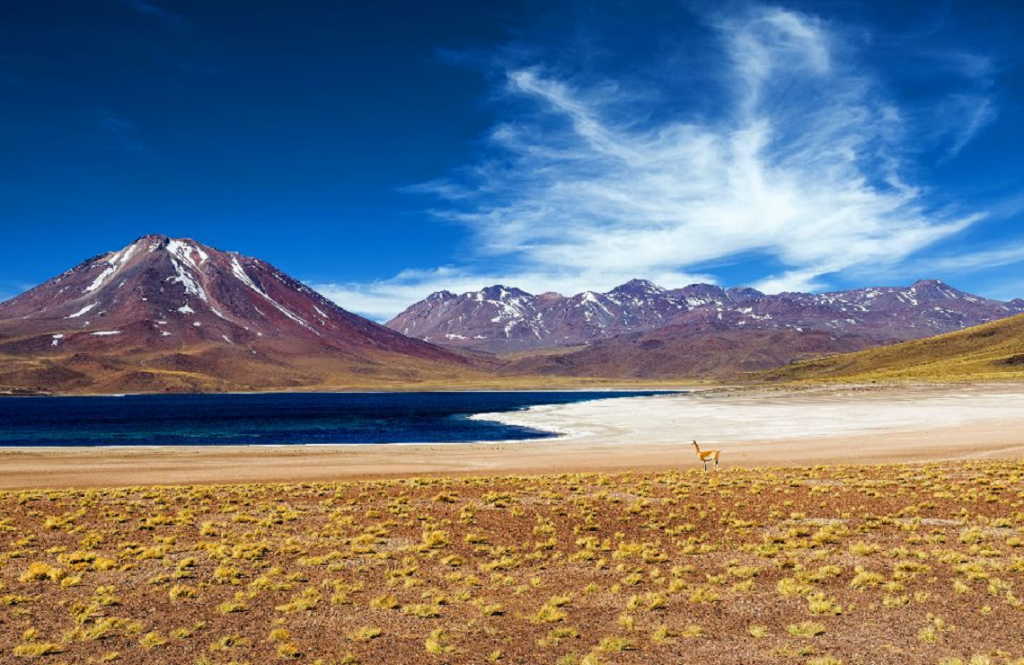Geography :
Chile has an interesting surface and topographic structure, in fact it stretches 4300 kilometers long, from Peru to Cape Horn. Chile is sometimes described as a tricontinental country because it claims a part of Antarctica and is present on South America and the Pacific with Easter Island.
- The Andes Mountains to the east mark the natural border with Bolivia and Argentina. The Ojos del Salado at 6893 m of altitude is the highest active volcano in the world. In the “Great North” we find the Atacama Desert which is the most arid desert in the world, known for the geysers of Tatio as well as the Valley of the Moon inhabited by the guanacos (species of camelids).
- The Cordillera de la Costa in the west to the Pacific Ocean, whose peaks reach an altitude of about 2,000 meters, with large natural reserves and lakes. And further south we find the Antarctic Peninsula where many cruises leave to discover the beauty of the ice floe and the fauna of the poles.
Between the two there are numerous coastal plains and plateaus, such as the Altiplano and the Atacama Desert and the Patagonian Pampas, as well as the Central Valley, which is the most populated area of Chile, where the big cities like Santiago de Chile are located. This valley has a very fertile land and has allowed the development of agriculture and supplies the big cities. Like the rest of the country, Chile’s climate is very different between the southern tip and the northern tip, with great variations between, for example, the city of Easter Island and the city of Valdivia. Chile also encounters the El Nino phenomenon, which brings heavy rainfall to the central Andes.
- Easter Island, whose original indigenous name is “Rapa Nui”, is a volcanic island belonging to Chile. About 900 huge statues, the Moai, which have human forms with disproportionate heads, have been found there. The history of the island remains a mystery to historians and offers a secluded and peaceful living environment to the approximately 7000 inhabitants. Be sure to visit Easter Island, on foot, by bike and walking on the beaches, pondering the possible origins of these megaliths.
History :
The history of Chile is marked by a succession of appropriations of territory, starting with the Incas, then the Spaniards and geographical changes that shape the present Chile:
- Pre-colonial era: during the pre-Columbian period, the main indigenous groups, including the Atacamas, Aymaras, Mapuches and many others moved to the Chilean territory due to different climatic changes. The Inca Empire extended to the north of the country and the ethnic groups found themselves under the sway of the Inca emperors.
- Spanish colonization in 1520, Fernando de Magellan arrived on the Chilean coasts, which was first named Tchili, probably in relation to an eponymous indigenous people. In search of “El Dorado”, other Spanish troops coming from Peru descend the Chilean coast until the foundation of the city of Santiago and the country will be placed under the supervision of the Viceroy of Peru.
Gastronomy:
Chilean cuisine is a mixture of Spanish and Mapuche (Chilean indigenous group) gastronomy and is characterized by the freshness of the products! The dishes are usually served in large quantities like a family kitchen. Very disputed with Peru, it is said that the origin of pisco would be Chilean. Indeed, when arriving in Chile, the Spaniards would have planted the first vines in several regions, including the Elqui Valley and La Serana where the climatic conditions were ideal. The other famous alcohol of the country is the wine, in the different regions like the Elqui Valley, the Aconcagua Valley or the Maipo Valley you will find many agricultural estates and the possibility to taste Chilean wine in the restaurant.
Cazuela is a typical Chilean dish with beef and vegetable broth and rice. This dish has its origins in Spanish influences and would be a variant of the olla podrida dish, with all kinds of meat, that the Spanish colonists had introduced. Some old recipes also show the presence of seafood and fish, so we can imagine the same dish with ingredients from the sea.
- The charquican is a kind of Chilean stew made with potatoes, corn, tomato and squash. It is a dish of Mapuche origin that was prepared with charqui (dried meat). Nowadays, it is cooked with beef and in different ways depending on the consistency and the amount of sauce and vegetables put in the dish.
- The pastel de choclo: This dish is similar to a minced meat dish. The mashed potatoes are replaced by half-ground corn. The meat is simmered with onions and grapes.
- The humitas are snacks made of cooked corn dough. Very popular in South America, they are available in sweet or savory recipes, according to taste and desire!
- The curanto is a typical dish from the island of Chiloé, it includes seafood, mussels, chicken and potatoes. There are two ways to cook it, either stewed under large leaves “al hoyo” or in a casserole, “en olla”.
- The chorillana is a potato dish with different types of meat. It is often accompanied by eggs and fried onions. This dish is similar to “lomo a lo pobre”, it is served in large quantities in the same dish to be shared between four and five people and often very accompanied by a beer.








